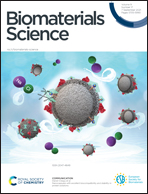Cyclic strain enhances the early stage mineral nucleation and the modulus of demineralized bone matrix†
Abstract
The adaptive response of bones to mechanical loading is essential for musculoskeletal development. Despite the importance of collagen in bone mineralization, little is known about how cyclic strain influences physicochemical responses of collagen, especially at the early stage of mineralization when the levels of strain are higher than those in mature bones. The findings in this study show that, without any cell-mediated activity, cyclic strain increases nucleation rates of calcium phosphate (CaP) nanocrystals in highly-organized collagen matrices. The cyclic strain enhances the transport of mineralization fluids with nucleation precursors into the matrix, thus forming more CaP nanocrystals and increasing the elastic modulus of the collagen matrix. The results also suggest that the multiscale spatial distribution of nanocrystals in the fibrous collagen network determines tissue-level mechanical properties more critically than the total mineral content. By linking nano- and micro-scale observations with tissue-level mechanical properties, we provide new insights into designing better biomaterials.



 Please wait while we load your content...
Please wait while we load your content...